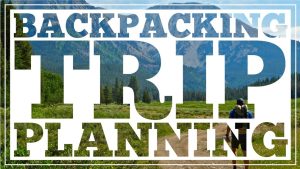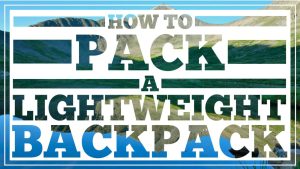Ep. 3 – How to Find and Fit the Right Backpack
We independently test everything we recommend.
Buying through links on our site supports our work.
Finding & Fitting The Right Backpack
Choosing the perfect backpack for your needs is greatly dependent on your personal preferences and your hiking style. If you’re a minimalist, you’ll probably prefer a simple, lightweight pack with a small frame.
If you’re going to be carrying heavier loads, you’ll likely want a pack with a sturdier frame to support the extra weight.
In either case, wearing a comfortable pack is partly about choosing the right size backpack for your body and partly about adjusting the pack so it will properly fit you.
Lightweight Packs
Over the years, I’ve found that simple, minimal, lightweight packs fit my needs much better, but that’s also because I’m carrying lightweight gear in my pack. A lightweight bag can quickly become uncomfortable if you try to stuff it full of heavy gear.
On the other hand, heavier packs with sturdy frames have more adjustments straps and are made to carry heavier loads comfortably, but remember, the more weight you carry on your back, the more stress you’ll be putting on your body. At some point in time, there’s really nothing you can do to make a heavy pack comfortable.
Whatever your preferences might be, take time to buy the right pack for your needs. You’ll probably have your backpack for years and it will be one of the most important pieces of equipment you own.
If you’re uncomfortable while you hike, you probably won’t enjoy backpacking very much and you certainly won’t be excited for your next trip. So take time and choose a bag that will fit you well.
Backpack Measurements
Choosing a pack to fit your body type is generally a function of two simple measurements, your torso length and your hip size.
Being tall or short doesn’t have anything to do with your torso length, so make sure to measure. One of the biggest mistakes new hikers make is choosing a backpack without measuring their torso size first. If you don’t take the time to measure your torso length, you won’t know the right size pack to buy. It’s just that simple.
To find your torso length, grab a soft tape measure and a friend. If you don’t have a soft tape measure, just use a length of rope and then lay it out flat to measure the length.
- Step 1) Tilt your head forward and find the bony bulge at the base of your neck. That’s your C7 vertebra and the top of your torso length.
- Step 2) Next, find the tops of your hipbones and place your hands on your hips with your thumbs pointing towards your spine. Where your thumbs would meet in the back of your spine is the bottom of your torso length.
- Step 3) Have a friend use the tape measure to follow the contour of your back and find your torso length.
Knowing your torso length will make buying the correct size pack much easier, especially if you’re buying from an online retailer where you won’t be able to try on the pack.
I’ve ordered several packs from online retailers and I’ve always been happy with the fit of my pack. Also, it’s easy to exchange or return a pack if the fit isn’t correct.
Hip Belt measurement
The next important measurement is hip belt size. You’ll want a comfortable hip belt with enough room for you to adjust it tighter and looser. You also might loose a little weight on longer trips, so make sure you have plenty of room to cinch down your hip straps.
Your hip belt is the most important load bearing structure on your pack, so make sure to get this measurement right.
Most companies will allow you to choose the hip belt size and torso size of your pack separately and some even have exchangeable belts. If a pack’s hip belt doesn’t fit you properly and you can’t change it, look for a different pack.
- To find your hip size, simply take your tape measure and wrap it around your waste at the top of your hips. That’s your hip belt measurement and it’s also the center point of where you want your pack to rest.
Pack Volume
The last size consideration for buying a new pack is its capacity. It is common for lightweight backpackers to use a pack that holds around 50 Liters of volume or less.
Backpackers carrying heavier loads should choose a pack that will hold around 60-70 Liters of volume. Just remember, more volume is not always better. More room often means that you’ll fill that space with unnecessary gear and add weight to your pack.
Pack Adjustments
Once you get your pack on the trail, you’ll want to make sure that it’s adjusted properly to fit your body.
The general rule of thumb for fitting your pack, especially for the first time, is to make sure that all of your straps are loose, and then to tighten them when you put your pack on.
Lightweight backpacks are very simple and often don’t have many adjustments to be made. Packs that are made to carry heavier weights will have a few other adjustment to make, but don’t worry if your pack is simple. More often than not, simple is better.
Start off by adjusting your hip belt. Your hip belt is meant to be the main load-bearing element of the pack.
Your hip belt should straddle the top of your hips, right where you measured your hip belt size. Make sure to readjust your hip belt every time you put your pack on to get the proper fit.
Shoulder Straps
Next, adjust your shoulder straps. Your shoulder straps are the second load-bearing element of your pack, but shouldn’t carry as much weight as your hips.
You shouldn’t feel a lot of strain in your shoulders while you hike. If that’s the case, your hip belt might need an adjustment or you might have a pack that’s torso length is too small.
Other Pack Adjustments
Other common pack adjustments are load lifter straps, sternum straps, and cinch straps.
Load lifter straps are located on top of your shoulder straps and they help to take pressure off of the top of your shoulders by pulling the weight of your backpack closer to your back. When you adjust your load lifter straps, they should be pulling at about a 45-degree angle away from your back.
Many lightweight bags don’t have load lifter straps because they’re not necessary if your bag is light enough. I generally find that load lifter straps don’t make a big difference for me.
Sternum straps are designed to pull your shoulder straps closer together, which will release some of the backwards pulling tension of your shoulder straps. Sternum straps are a minor adjustment that shouldn’t be considered mandatory.
I use mine sometimes to ease tension in my shoulders, but I also find that they can restrict my breathing slightly by compressing my chest. A small elastic section on a sternum strap can help with this.
Cinch straps can be used to compress the weight of your bag closer to your back and make your pack more efficient to carry.
After you’ve made these final adjustments, you should be good to hit the trail with a comfortable fitting backpack.
Adjust As Needed
Don’t be afraid to make adjustments to your pack throughout the day while you hike. I often find that I make small adjustments to let up pressure when certain parts of my body start feeling sore.
- I might let up my shoulder straps to carry more weight on my hips and release pressure from my back.
- I might clip, unclip, or adjust my sternum strap to change up my shoulder strap positions.
- I might even unclip my hip belt while I hike for a while to place all of my pack weight on my shoulders and give my hips a brief rest.
Remember, with a really light bag it’s easy to make quick adjustments that will allow you to hike comfortably. And when you’re more comfortable while you hike, you’re going to have much better time on your trip.
MORE EPISODES IN THIS SERIES
View all





